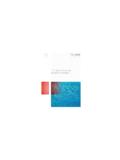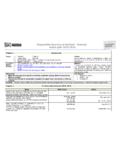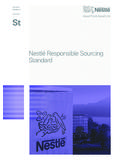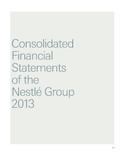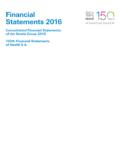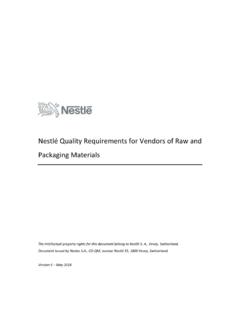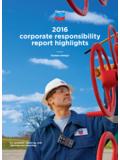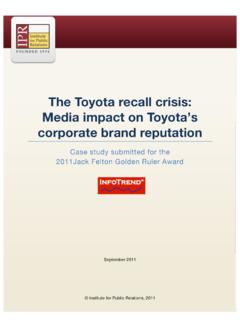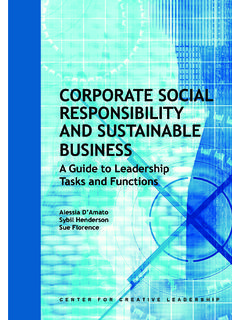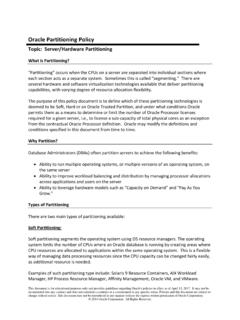Transcription of Nestlé Responsible Sourcing Standard - nestle.com
1 Nestl Responsible Sourcing GuidelineGuidelineRecommendedSeptember 2013 Issuing departmentCorporate ProcurementTarget audienceSuppliers and subtier suppliersNestl ProcurementApproverMarco GoncalvesRepositoryAll Nestl Principles and Policies, Standards and Guidelines can be found in the Centre online repository at: NestleDocsCopyrightAll rights belong to Nestec Ltd., Vevey, Switzerland. 2013, Nestec 20131 Nestl Responsible Sourcing Guideline 2 Introduction to Nestl Responsible Sourcing Guideline 3 General Principles General Requirements Material Specific Requirements 6 Palm oil 7 Paper & Board 9 Sugar10 Soya11 C o c o a12 Cof fee13 Dairy14 Fish & Seafood16 Meat, Poultry & Eggs18 Vanilla Hazelnuts Shea19 Understanding Forest Conversion / Deforestation20 Approved Means of Verifying that Supplies meet the RSG Table of contents2 Nestl Responsible Sourcing GuidelineThe Responsible Sourcing Guideline (RSG)
2 Complements the Nestl Supplier Code and is applicable to all stages of the upstream value chain back to the primary production level. The RSG is meant to be complemented, as appropriate, with additional guidelines, specifications and practical tools1 at local or regional level (according to the region and its climates, ecological variables, farming systems, cultures, consumer preferences, etc.) and respecting national laws and aim of the RSG is to guide Nestl s suppliers to improve their practices where necessary and the Nestl Businesses in the implementation of international standards and Nestl own policies and commitments relating to Responsible Sourcing : Nestl Supplier Code Nestl Policy on Environmental Sustainability Nestl Commitment on Climate Change Nestl Commitment on Deforestation and Forest Stewardship Nestl Commitment on Child Labour in Agricultural Supply Chains Nestl Commitment on Rural Development Nestl Commitment on Farm Animal Welfare Nestl Commitment on Water Stewardship The International Bill of Human Rights The 8 ILO Core Conventions United Nations Global Compact PrinciplesThe General RSG comprises three sections:1.
3 The General Principles drive the overall concept remove the worst, promote the best, improve the rest 2. The General Requirements apply to all materials of agricultural, forestry, fishery and aquaculture origin 3. The Material Specific Requirements complement the General Principles and Requirements by defining additional priority areas for the material in question. Introduction to Nestl Responsible Sourcing Guideline 1 For example the RISE tool (Response Inducing Sustainability Evaluation) which is an indicator-based sustainability assessment tool at farm level to identify strengths and weaknesses of environmental, social and economical performance, including the requirements of the Nestl Responsible Sourcing Guideline General Principles General Requirementsa) Continuous improvement:Nestl is committed to continuously increasing the share of raw and packaging material sourced in compliance with the RSG.
4 All Nestl suppliers are expected to engage in a process of continuous improvement and to verify their processes and practices against the ) Transparency along the value chainNestl expects its suppliers to conduct their business with Nestl in an open and transparent way, which includes providing transparency of material flows throughout the entire upstream value chain providing evidence of product identity and that no adulteration has happened, with the overall objective to ensure the supply of responsibly produced products. Suppliers provide accurate information on all aspects covered by the Legal complianceSuppliers1 comply with all applicable laws and Human rights and labour practices as stated in the Nestl Supplier Codea.
5 No use of forced or child There is no use of forced or compulsory labour as per ILO Conventions 29 and 105. ii. There is no use of child labour. Child labour refers to work that is mentally, physically, socially, morally dangerous or harmful to children or that improperly interferes with schooling needs as per Nestl Supplier Code and ILO Conventions 138 and Workers pay and conditions meet at least legal or mandatory industry Workers pay and benefits comply with minimum legal requirements or mandatory industry standards, including any applicable binding collective agreements. ii. Working conditions comply with applicable laws and industry norms, including working c) Supplier accountability and supplier support Nestl expects its suppliers to take ownership and leadership in developing and implementing continuous improvement measures against all aspects of the RSG.
6 As appropriate, Nestl will provide support to suppliers that are not yet able to comply with all aspects of the RSG, but are committed to becoming compliant over time and demonstrate continuous and tangible progress. d) Credible verification In its extended value chains, Nestl expects its suppliers to continuously monitor and verify their performance and continuous improvement against the RSG. In the case of high sustainability risks, Nestl reserves the right to verify such monitoring and performance by independent assessments or , housing (where applicable), water and sanitation, specific gender-related needs, medical and welfare Freedom of association and collective bargaining is respected, unless prevented by The rights of workers to freedom of association and collective bargaining are respected, consistent with applicable ILO Conventions 87 and 98 and those identified by the United Nations Universal Declaration of Human Rights.
7 D. Provision of safe and healthy Workers are provided with a safe and healthy workplace, including, as applicable, safe housing conditions. As a minimum, potable drinking water, adequate sanitation, emergency exits, essential safety equipment and access to emergency medical care are Throughout the RSG, the term supplier includes all sub-suppliers back to the primary production stage. 4 Nestl Responsible Sourcing Guidelinee. No discrimination on the basis of gender, race, ethnicity, age or Hiring and employment practices do not discriminate on the ground of criteria such as race, colour, religion, sex, age, physical ability, maternity, religion, ethnicity, physical conditions or political views as per ILO C o n v e n t i o n Conversion of natural vegetationa.
8 No Sourcing from areas converted from naturals forests1 after 1 February Products are sourced from land that has not been converted from natural forest to other land Identification and protection of High Conservation Values (HCVs) Products are sourced in a manner that maintains or enhances high conservation values in the surrounding High carbon stocks (including above ground carbon values and soils that provide important carbon and water storage functions) are included as a high conservation value and Nestl will develop appropriate Suppliers will pay particular attention to high conservation values needed to preserve water stewardship, livelihoods, and species that require large contiguous Suppliers will not source products from IUCN protected areas categories I-IV, UNESCO World Heritage Sites and wetlands on the Ramsar HCV areas have management plans that ensure the maintenance and/or enhancement of these areas and maximize connectivity of natural habitats within the Environmental impactsa.
9 Impacts on water are mitigated by implementation of water management plans, and additional measures in water-stressed Water withdrawal from the environment is minimized and water pollution is Suppliers have carried out impact assessments that include water resource assessments, and are implementing management plans that include water management. Water management takes into account the human right to water as well as environmental flows and water Suppliers in water-stressed areas undertake additional measures with the objective of mitigation impacts of water Use of chemicals is consistent with best agricultural Growers comply with best practices relating to use of Pest and disease management is based on Integrated Pest Management programs that reduce the need for agrochemicals and provide appropriate safeguards for workers and high conservation value areas when agrochemicals are Soil management is consistent with best agricultural Growers comply with best practices relating to soil management, taking into consideration soil structure and fertility.
10 And soil Fertilisers are applied in response to appropriate soil testing and in ways that minimize run-off of nutrients and emissions of GHG. iii. Soil carbon levels are maintained and measures taken to enhance them where these benefit soil health and crop Agrochemical use is minimised to deliver upon good soil conservation practices, whilst being consistent with the need to control invasive species and Suppliers identify and reduce their significant environmental impacts in a process of continuous improvement, which includes, as applicable, the following aspects: i. Waste is prevented, reused, recycled, recovered and/or disposed of in an environmentally sustainable wayii. Biodiversity is maintained and/or enhancediii. Greenhouse gas emissions are reduced iv.
